Is Pink Chicken Safe to Eat
Pink chicken can be safe to eat, but you shouldn't rely on color alone to determine doneness. The key is verifying the internal temperature reaches 165°F (75°C), as recommended by the USDA. Factors like myoglobin content, cooking methods, and the bird's age can cause chicken to remain pink even when fully cooked. Always use a digital meat thermometer to check the thickest part of the meat, avoiding bones for accurate readings. Remember, clear juices don't guarantee safety, and some pinkness may persist in properly cooked chicken. By focusing on temperature rather than appearance, you'll verify your chicken is both safe and delicious. Exploring proper cooking techniques can further enhance your culinary skills.
This post may contain affiliate links. If you make a purchase through these links, I may earn a commission at no additional cost to you. Additionally, portions of this post may be generated using artificial intelligence (AI) technology. While we strive for accuracy, please be aware that AI-generated content may not always be perfect and should be fact-checked when necessary.
The Spatula Scoops
- Pink chicken can be safe to eat if it reaches an internal temperature of 165°F (75°C).
- Color alone is not a reliable indicator of doneness; use a meat thermometer for accuracy.
- Certain factors like age, cooking method, and cut can cause chicken to remain pink when fully cooked.
- Undercooked chicken poses risks of foodborne illnesses, primarily from Salmonella and Campylobacter bacteria.
- Safe handling practices and proper cooking temperatures are crucial to prevent bacterial contamination and ensure food safety.
Understanding Pink Chicken
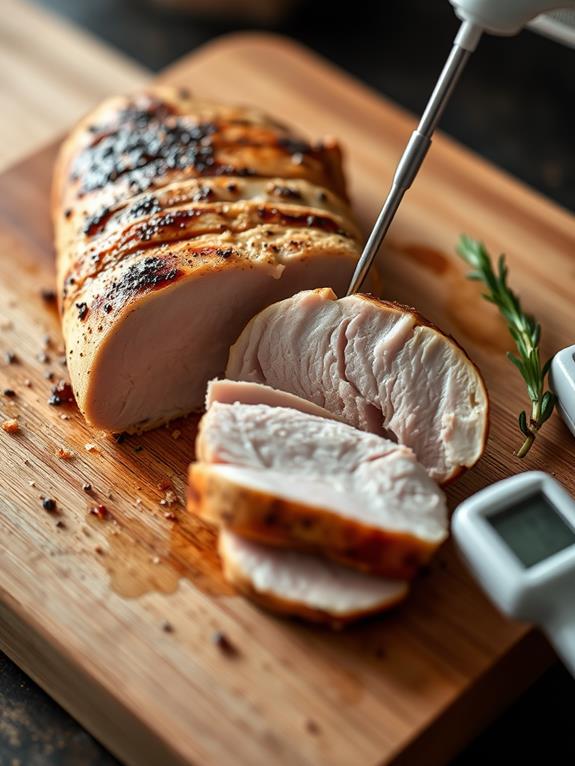
While many people assume pink chicken is always undercooked and unsafe, that's not necessarily the case. The color of cooked chicken can be misleading, and it's important to understand the factors that contribute to its appearance. Like with other meats, the safety of proper cooking methods plays a vital role in making certain the chicken is edible.
You might be surprised to learn that pink chicken can sometimes be safe to eat. The presence of myoglobin, a protein found in muscle tissues, can cause dark meat to retain a pink hue even when fully cooked. This is particularly common in young chickens, where permeable bones and skin allow for myoglobin reactions during cooking. Additionally, certain cooking methods like slow cooking or smoking can result in a pink appearance while still confirming the chicken is safe to consume.
It's important to remember that color alone isn't a reliable indicator of doneness. The USDA recommends using a meat thermometer to check that your chicken reaches a safe internal temperature of 165°F (75°C), regardless of its color. This temperature guarantees that harmful bacteria are eliminated, making the chicken safe to eat. Other factors, such as feed composition, animal stress, and freezing methods, can also affect the final color of cooked chicken, potentially leading to misleading appearances.
Cooking Temperature Guidelines

To guarantee your chicken is safe to eat, you'll need to follow recommended internal temperature guidelines. The USDA advises cooking all poultry to a minimum of 165°F (75°C), which you can verify using a digital thermometer inserted into the thickest part of the meat. To enhance your cooking experience, consider using high-quality kitchen tools, such as a reliable stand mixer for preparing sides and batters to complement your dish, like with the KitchenAid® 7 Quart Bowl-Lift Stand Mixer. While dark meat can be cooked to higher temperatures for better flavor, it's essential to reach at least the minimum temperature throughout the entire piece to eliminate harmful bacteria.
Recommended Internal Temperatures
The most essential guideline for cooking chicken safely is to assure it reaches the right internal temperature. To assure your chicken is fully cooked and safe to eat, you'll need to use a digital thermometer to check its temperature. Insert the thermometer into the thickest part of the meat, avoiding bones for an accurate reading.
The USDA recommends that all poultry reach a minimum internal temperature of 165°F (75°C). However, there are some variations depending on the type of chicken and cooking method:
| Type of Chicken | Minimum Temperature | Cooking Time |
|---|---|---|
| Whole Chicken | 165°F (75°C) | Until done |
| Chicken Breast | 165°F (75°C) | Until done |
| Ground Chicken | 165°F (75°C) | Until done |
It's important to note that while 165°F is the minimum safe temperature, cooking dark meat to a higher temperature, such as 195°F (90°C), can enhance its juiciness. Additionally, if you're able to monitor the temperature consistently, you can hold chicken at 155°F (68°C) for at least 44 seconds to achieve a safe internal temperature. Remember, properly cooked chicken isn't always white; some pinkness can be safe if the correct temperature is reached.
Digital Thermometer Accuracy
Accurate digital thermometers are essential for guaranteeing your chicken reaches a safe internal temperature. When it comes to food safety, you can't rely on visual cues alone. A digital thermometer is your best tool for determining if your chicken is properly cooked.
To use a digital thermometer effectively, insert it into the thickest part of the meat. This guarantees you're measuring the temperature of the entire piece, not just the surface. For larger or bone-in cuts, you'll want to check multiple spots to confirm even cooking throughout.
Instant-read thermometers are particularly useful, providing quick readings in just 5 to 10 seconds. This allows you to monitor your chicken's progress without losing too much heat from the oven or grill. Remember, the minimum safe internal temperature for chicken is 165°F (75°C).
Color Indicators of Doneness

Cooks often rely on visual cues to determine if their chicken is fully cooked, but color alone can be deceiving. You might assume that white meat without any pinkness indicates safe-to-eat chicken, but this isn't always the case. While properly cooked chicken typically displays white meat and clear juices, there are exceptions you should be aware of to avoid food poisoning. For example, just as with expiration and safety of oatmeal, dark meat, like thighs and drumsticks, may retain a slight pink hue even when fully cooked. This is due to myoglobin, a protein that can cause a pink tinge. Additionally, cooking methods such as grilling or smoking can intensify the meat's pinkness, potentially misleading you about its doneness.
It's essential to understand that the presence of pink in chicken doesn't always mean it's undercooked. Factors like the bird's age and muscle composition can influence its color. To guarantee your chicken is safe to eat, don't rely solely on visual cues. Instead, use a reliable meat thermometer to verify that the internal temperature reaches 165°F (75°C) throughout the meat. This method is the most accurate way to prevent foodborne illnesses and confirm your chicken is thoroughly cooked.
Risks of Undercooked Poultry
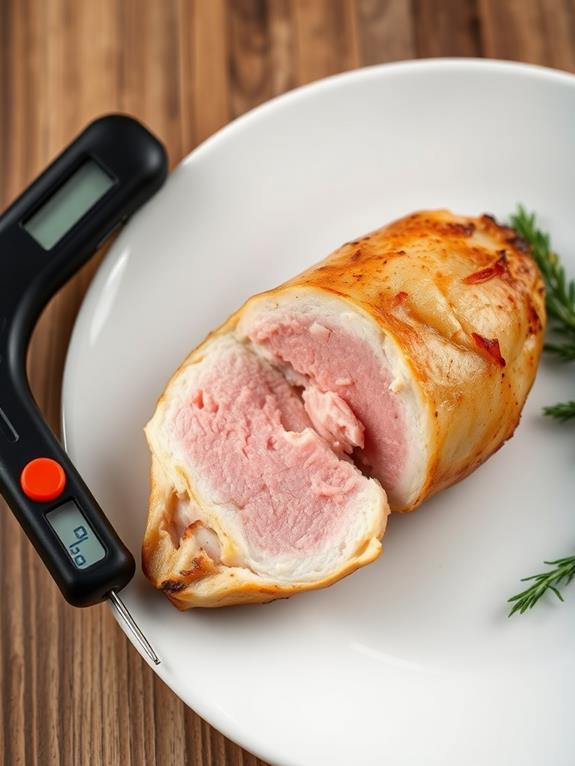
When you consume undercooked chicken, you're exposing yourself to serious foodborne illness dangers, primarily from bacteria like Salmonella and Campylobacter. These harmful pathogens can thrive in poultry that hasn't reached the correct internal temperature, which greatly increases your risk of contracting foodborne illnesses. These bacterial contamination risks can lead to a range of symptoms, including diarrhea, fever, and abdominal pain, which may require medical attention. It's vital to understand that proper cooking methods are your best defense against these risks, as reaching the recommended internal temperature of 165°F (75°C) effectively eliminates harmful pathogens, just as the recommended cooking temperatures for other meats guarantee safety.
Foodborne Illness Dangers
Consuming undercooked poultry can open up a can of worms when it comes to foodborne illnesses. You're putting yourself at risk for some nasty bacterial infections, primarily Salmonella and Campylobacter. These pathogens are commonly found in raw chicken and can lead to a host of unpleasant symptoms if you don't cook your poultry thoroughly.
When you eat undercooked chicken, you might experience diarrhea, abdominal pain, and fever. But it doesn't stop there. In some cases, these infections can lead to more severe complications like reactive arthritis or Guillain-Barré syndrome. The numbers are staggering: Scotland alone reported about 6,000 cases of Campylobacter food poisoning last year. In the United States, Salmonella causes an estimated 1.35 million infections annually, resulting in 26,500 hospitalizations and 420 deaths.
To protect yourself from these foodborne illness dangers, it's essential to cook your chicken properly. Always verify that the internal temperature reaches at least 165°F (75°C). This temperature is key to eliminating harmful bacteria and keeping you safe from the potentially serious consequences of undercooked poultry.
Bacterial Contamination Risks
Chicken's bacterial risks are no joke when it's undercooked. Raw chicken can harbor dangerous pathogens like Salmonella and Campylobacter, which can lead to severe foodborne illnesses. When you're cooking chicken, it's essential to guarantee it reaches the proper internal temperature to kill these harmful bacteria.
The consequences of consuming undercooked poultry can be serious. You might experience:
- Diarrhea and abdominal pain
- Fever and other flu-like symptoms
- Potential long-term complications, such as irritable bowel syndrome
To protect yourself, always cook chicken to a minimum internal temperature of 165°F (75°C). This isn't just a suggestion; it's a vital food safety measure recommended by the USDA. Using a digital thermometer is the most reliable way to check if your chicken is fully cooked.
Consider the fact that Scotland reported about 6,000 Campylobacter cases last year, highlighting how common these infections can be. By following safe cooking practices, you'll greatly reduce your risk of bacterial contamination. Remember, when it comes to chicken, it's always better to err on the side of caution.
Symptoms of Undercooking
Undercooked poultry poses serious health risks that you shouldn't ignore. When you consume undercooked chicken, you're exposing yourself to harmful bacteria like salmonella and campylobacter. These pathogens can lead to foodborne illnesses, causing a range of unpleasant symptoms.
You might experience diarrhea, abdominal pain, and fever within 6 to 72 hours after eating undercooked chicken. While some cases may result in mild gastrointestinal discomfort, others can lead to severe complications. In rare instances, you could develop reactive arthritis or Guillain-Barré syndrome.
It's important to note that certain groups are more vulnerable to these risks. If you're a young child, elderly, or have a weakened immune system, you're particularly susceptible to severe symptoms from undercooked poultry. To protect yourself and your loved ones, always cook chicken to a minimum internal temperature of 165°F (75°C). This step is essential in eliminating harmful bacteria and reducing the risk of foodborne illnesses.
Factors Affecting Chicken Color
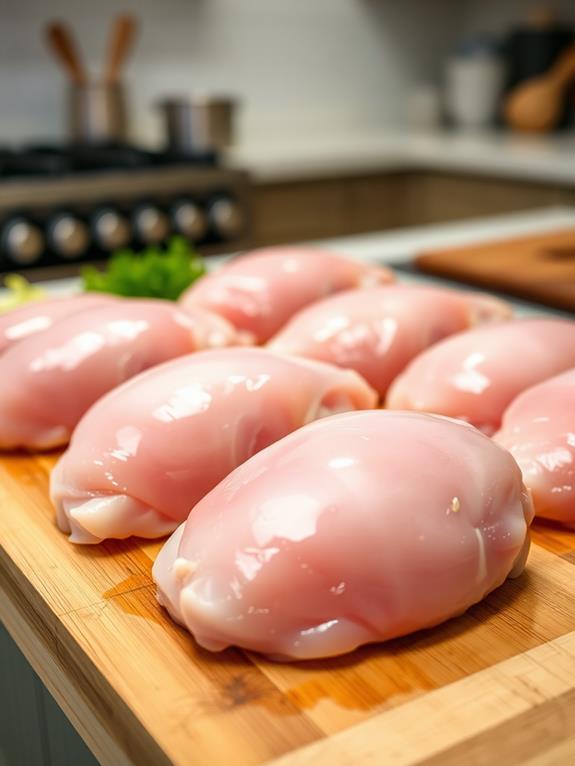
Several factors influence the color of cooked chicken, which can sometimes lead to confusion about its safety. When you're cooking chicken, you might notice that the color doesn't always turn out as expected. This variation can be due to:
- The age of the chicken
- The cooking method used
- The type of meat (dark or white)
Younger chickens often retain a pink hue even when fully cooked, thanks to their more permeable bones and skin. If you're grilling or smoking your chicken, you might see an intensified pink color, while sous-vide cooking can result in a pink glow even when the meat is safe to eat. This confusion can be exacerbated by the fact that improper storage or leaving chicken out can promote harmful bacterial growth, leading to unsafe consumption, as highlighted in food safety guidelines. Dark meat, like thighs and legs, may naturally appear pinker than white meat after cooking.
Marinades can also affect your chicken's color, sometimes causing unexpected changes during the cooking process. Additionally, the thickness of your chicken cuts plays a role in how quickly the color changes. Thicker pieces may require longer cooking times to reach safe internal temperatures and achieve the expected color throughout. Remember, color alone isn't always a reliable indicator of doneness.
Safe Handling Practices

Safety is paramount when handling raw chicken to prevent foodborne illnesses. When you're preparing chicken, it's essential to follow safe handling practices to avoid contamination. Always wash your hands, utensils, and surfaces with hot, soapy water after touching raw chicken. Use separate cutting boards for raw chicken and other foods to prevent cross-contamination.
Here's a quick guide to safe chicken handling:
| Step | Do | Don't |
|---|---|---|
| Storage | Keep raw chicken on bottom shelf | Store above other foods |
| Preparation | Use separate utensils | Reuse marinades from raw meat |
| Cooking | Cook to 165°F (75°C) internal temp | Serve undercooked chicken |
When you cook chicken, make sure it reaches the proper internal temperature. Use a meat thermometer to check that it's at least 165°F (75°C) throughout. This temperature kills harmful bacteria, making the chicken safe to eat regardless of its color.
Remember to store raw chicken in the refrigerator at or below 40°F (4°C). By following these safe handling practices, you'll greatly reduce the risk of foodborne illnesses and make certain your chicken dishes are both delicious and safe to consume.
Myth-Busting Pink Chicken Beliefs
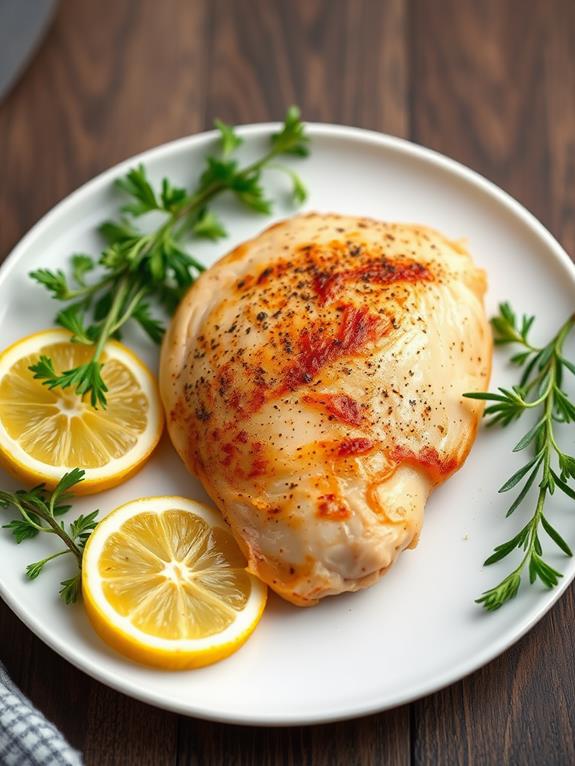
Misconceptions about pink chicken have long been a source of confusion for home cooks and diners alike. It's time to debunk some common myths about pink poultry. Contrary to popular belief, pink chicken can be safely cooked. The color alone isn't a reliable indicator of doneness. Here are three key factors to take into account:
- Myoglobin presence: This protein can cause dark meat to retain a pink hue even when fully cooked. Incorporating techniques such as proper seasoning can also enhance the cooking experience, much like using a Lodge cast iron skillet for evenly cooked meals.
- Internal temperature: The USDA recommends 165°F (75°C) as the safe minimum temperature for poultry, regardless of color.
- Chicken characteristics: Age, cooking method, and pH levels can all influence the meat's final color.
You might be surprised to learn that clear juices don't guarantee safety, and pink juices can occur in properly cooked chicken, especially in younger birds. The key to determining if your chicken is safely cooked is using a meat thermometer. By understanding these factors, you can confidently enjoy your poultry without unnecessary fears about pink coloration. Remember, it's the internal temperature that matters most, not the visual appearance of the meat.
Using Meat Thermometers Effectively
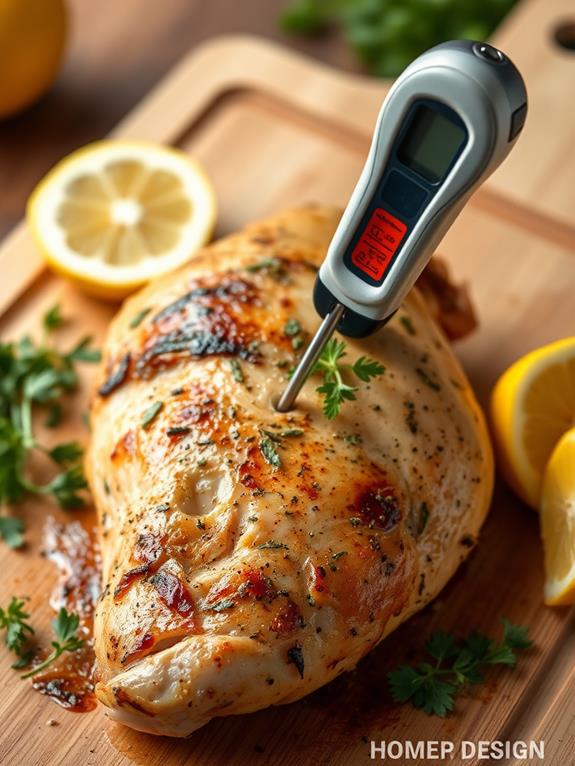
For accurate and safe chicken preparation, mastering the use of a meat thermometer is vital. While you might have heard that chicken is done when the juices run clear, this isn't a reliable method. Instead, always use a digital meat thermometer to guarantee your chicken reaches the safe internal temperature of 165°F (75°C). Using quality kitchen tools, like the Pyrex measuring cups, enhances your cooking experience and guarantees precision in your recipes.
To use your thermometer effectively, insert it into the thickest part of the chicken, avoiding bones. This gives you the most accurate reading. For whole chickens, it's best to check multiple spots to confirm even cooking throughout. Remember, the USDA recommends this temperature to eliminate harmful bacteria.
After each use, clean your thermometer with hot, soapy water to prevent cross-contamination. This simple step is vital for maintaining food safety in your kitchen.
Once your chicken reaches the right temperature, don't forget to let it rest. This allows the juices to redistribute, potentially raising the internal temperature slightly and enhancing both safety and flavor. By following these steps, you'll guarantee your chicken is not only safe but also delicious every time.
Alternative Doneness Tests
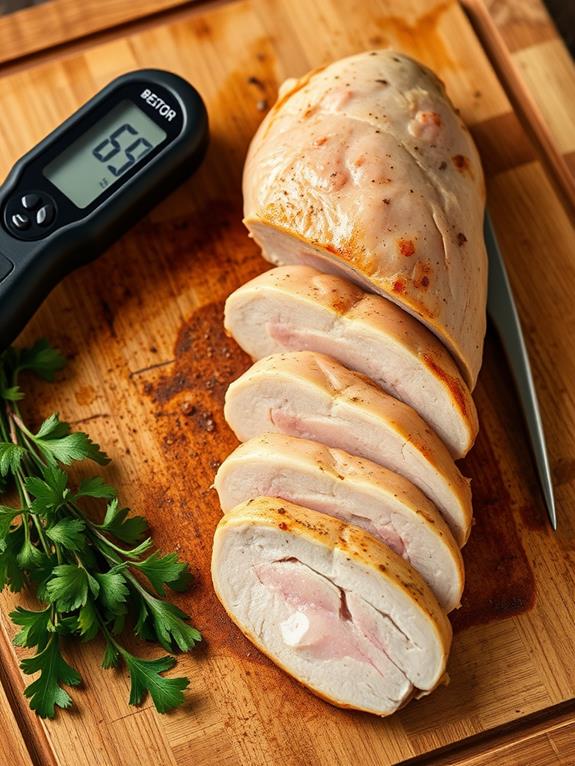
While meat thermometers are the gold standard for checking chicken doneness, it's helpful to understand alternative methods. When cooking chicken, you might be tempted to rely on visual cues, but these can be misleading. Pink chicken doesn't always mean it's unsafe, and clear juices don't guarantee doneness. Instead, consider these additional indicators: Additionally, ensuring your cooking tools are effective is key—as with a high-performance appliance like the Vitamix 5200 Blender, which allows for great texture in various recipes.
- Texture: Fully cooked chicken should feel firm and springy when pressed.
- Firmness: The meat shouldn't feel mushy or overly soft.
- Thickness: Assess the thickest part of the meat for a more accurate gauge.
Frequently Asked Questions
Is Chicken Ok if It's a Little Pink?
You shouldn't rely solely on color to determine if chicken is safe to eat. While a little pink doesn't always mean it's undercooked, it's essential to use a digital thermometer to check the internal temperature. Aim for 165°F (75°C) at the thickest part. Remember, factors like the chicken's age, breed, and cooking method can affect its final color. To guarantee safety, always prioritize temperature over appearance. When in doubt, it's better to cook it a bit longer or check with a thermometer.
Why Is Chicken Still Pink After Cooking?
You might be surprised to find your chicken still sporting a rosy hue after cooking. Don't worry, it's not always a sign of underdone poultry. Several factors can contribute to this pink appearance. Myoglobin, a protein in dark meat, can retain its color even when fully cooked. Young chickens may have more permeable bones and skin, allowing color to seep through. Certain cooking methods, like smoking or grilling, can preserve pinkness. Even freezing can affect the meat's color after cooking.
Is Chicken Slightly Pink but Juices Clear?
If your chicken is slightly pink but the juices are clear, it might be safe to eat. However, you shouldn't rely solely on visual cues. The most reliable method is to use a meat thermometer to check the internal temperature. Confirm it's reached 165°F (75°C) in the thickest part. Remember, some chicken parts can retain a pink hue due to factors like myoglobin content or cooking method, even when fully cooked. Always prioritize temperature over color for food safety.
Is Slightly Undercooked Chicken Ok?
Like a ticking time bomb, slightly undercooked chicken isn't worth the risk. You shouldn't consume it. Even if it's just a bit pink, it can harbor dangerous bacteria like Salmonella. While you might feel tempted to chance it, the potential consequences aren't worth it. Always use a meat thermometer to verify your chicken reaches 165°F (75°C) throughout. Don't rely on color or juices alone. Your health is too important to gamble with undercooked poultry.





